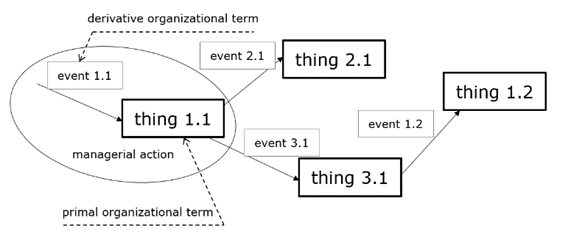The system of organizational terms is a methodological complex which consists of ontological and epistemological aspects designed for research team management aimed at team management automation. The philosophical foundation of the system of organizational terms is based on Wittgenstein’s philosophy, his theory of facts (the only beings in the world) and “states of facts”. According to this approach the organizational reality can be represented by events and things. Specifically, as shown in Figure 1, each event and thing have the label n.m, in which n and m represent a number and a version of a thing, respectively. Event 1.1 causes thing 1.1, which in turn releases event 2.1 that creates thing 2.1. Thing 1.1 simultaneously starts event 3.1 which creates thing 3.1. Then, thing 3.1 generates a new version of the first event, i.e. event 1.2. In such a way, a new version of the first thing (1.1) is created and it is called thing 1.2.
Every event and thing is an organizational term, although the things are called primal organizational terms and the events are called derivative organizational terms. The way of labelling comes from the answer to a simple question: what would exist when a team manager stops doing anything? The answer is: things would exist as they are more stable and coherent over time comparing to events.

Figure 1. Fundamental structure of organizational reality based on occurring facts
Things (primal organizational terms) in the organizational reality represent resources. Events (derivative organizational terms) in the organizational reality represent processes. By the same token, the system of organizational terms combines the resource approach and the process approach in the management science in a way that team management processes effect in team’s resources.
Therefore the managerial actions is defined as a real activity, which a manager does in order to play a managerial role when he has a certain managerial skill, the managerial action structure consist of, e.g. event 1.1 and thing 1.1. This is shown in Figure 1.
Despite the fact that on the abstract level this approach is quite clear and easy to understand, a real problem concerns a method of measuring certain organizational terms. It is quite obvious that data which describe organizational terms should be recorded in a way, which allows to represent a team manager unambiguously without any doubts or subjective conclusions. This problem can be described by two questions: (1) which organizational terms could we measure and (2) how to do it? The project of the system of organizational terms includes answers to both questions.
Firstly, it is possible to measure only things as effects of processes. Even when we try to measure a process, its parameters must concern a state of the world before and after when this process happens. This means that the parameters concern some kind of a resource which is being changed during this process. In team management this issue looks as it follows.
As it is shown in Figure 2, when a team manager sets a goal (a team management process represented by Event 1.1 – setting 1.1), it is possible to measure features of goal 1.1 in content, time, and human relations domain. If later (e.g. after describing a task – describing 1.1 and task 1.1) this team manager does the next setting of the same goal, he launches the next team management process. Then the features of this team management process are changed and represent the second version of this team management process (setting 1.2 and goal 1.2). The difference between features of goal 1.2 and goal 1.1. let do reasoning on the team management process which happened in this period of time. Such an approach to ontology of team management lets represent all such processes by standardized features vectors with data grouped in content, time and psychosocial domains.

Figure 2. The example of creating resources by processes in team management
Secondly, if it is only possible to measure things (e.g. goal 1.1), there should be a special research tool which could let record the parameters of goal 1.1 keeping to the rule of minimum influence on a team manager. The solution is a research tool built-in a management tool, which a team manager uses during day-to-day work. In other words, when a manager does something (e.g. set a goal) with a certain tool, this tool should record the parameters of the goal during the managerial work (e.g. before and after setting).
In order to verify the assumptions of the system of organizational terms described above the innovative online management tools were designed and implemented. There are in TransistorsHead.com research platform. This approach partly based on a well-known method of time and motion study in management science. The author conducted several experiments on recording managerial actions based on this approach, showing the potential of this concept in team management automation.
